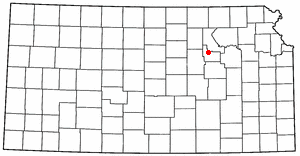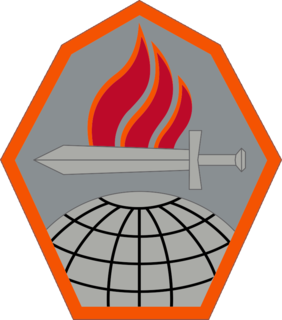Related Research Articles

Fort Rucker is a U.S. Army post located primarily in Dale County, Alabama, United States. It was named for a Civil War officer, Confederate General Edmund Rucker. The post is the primary flight training installation for U.S. Army Aviators and is home to the United States Army Aviation Center of Excellence (USAACE) and the United States Army Aviation Museum. Small sections of the post also lie in Coffee, Geneva, and Houston counties. Part of the Dale County section of the base is a census-designated place; its population was 4,636 at the 2010 census.

Fort Riley is a United States Army installation located in North Central Kansas, on the Kansas River, also known as the Kaw, between Junction City and Manhattan. The Fort Riley Military Reservation covers 101,733 acres (41,170 ha) in Geary and Riley counties. The portion of the fort that contains housing development is part of the Fort Riley census-designated place, with a residential population of 7,761 as of the 2010 census. The fort has a daytime population of nearly 25,000. The ZIP Code is 66442.

The 54th Massachusetts Infantry Regiment was an infantry regiment that saw extensive service in the Union Army during the American Civil War. The unit was the second African-American regiment, following the 1st Kansas Colored Volunteer Infantry Regiment, organized in the northern states during the Civil War. Authorized by the Emancipation Proclamation, the regiment consisted of African-American enlisted men commanded by white officers.

Fort Benning is a United States Army post straddling the Alabama–Georgia border next to Columbus, Georgia. Fort Benning supports more than 120,000 active-duty military, family members, reserve component soldiers, retirees and civilian employees on a daily basis. It is a power projection platform, and possesses the capability to deploy combat-ready forces by air, rail, and highway. Fort Benning is the home of the United States Army Maneuver Center of Excellence, the United States Army Armor School, United States Army Infantry School, the Western Hemisphere Institute for Security Cooperation, elements of the 75th Ranger Regiment, the 1st Security Force Assistance Brigade, and other tenant units.

Fort Devens is an inactive United States Army military installation in the towns of Ayer and Shirley, in Middlesex County and Harvard in Worcester County in the U.S. state of Massachusetts. It was named after jurist and Civil War general Charles Devens. The nearby Devens Reserve Forces Training Area is located in Lancaster. Although closed in 1996, the fort was reopened the next day as the Devens Reserve Forces Training Area. The name reverted to Fort Devens in May 2007.

Fort Gordon, formerly known as Camp Gordon, is a United States Army installation established in October 1941. It is the current home of the United States Army Signal Corps, United States Army Cyber Command, and the Cyber Center of Excellence. It was once the home of The Provost Marshal General School and Civil Affairs School. The fort is located southwest of Augusta, Georgia. One of the major components of the installation is Advanced Individual Training for Signal Corps military occupational specialties. Signals Intelligence has become more visible and comprises more and more of the fort's duties.

Readville is part of the Hyde Park neighborhood of Boston. Readville's zip code is 02136. It was called Dedham Low Plains from 1655 until renaming in 1847 after mill owner James Read. It was part of Dedham until 1867. It is served by Readville station on the MBTA Commuter Rail. It is on the original alignment of Route 128, later part of a since-discontinued section of Route 135. Readville is bordered by the Town of Milton to the south and Town of Dedham to the west. Paul's Bridge, which is at the neighborhood's entrance as one approaches from Milton, is one of the oldest bridges in the Commonwealth. The name comes from James Read, a resident and cotton mill owner. Readville is covered by Boston Police Department District E-18 in Hyde Park and a fire station on Neponset Valley Parkway houses Boston Engine Company 49. Readville is also home to several light industries.

The 7th Regiment of the New York Militia, aka the "Silk Stocking" regiment, was an infantry regiment in the Union Army during the American Civil War. Also known as the "Blue-Bloods" due to the disproportionate number of its members who were part of New York City's social elite, the 7th Militia was a pre-war New York Militia unit that was mustered into federal service for the Civil War.

The 71st New York Infantry Regiment is an organization of the New York State Guard. Formerly, the 71st Infantry was a regiment of the New York State Militia and then the Army National Guard from 1850 to 1993. The regiment was not renumbered during the early 1920s Army reorganization due to being broken up to staff other units from 1917–1919, and never received a numerical designation corresponding to that of a National Guard regiment.

The 101st Field Artillery regiment is the oldest field artillery regiment in the United States Army with a lineage dating to 13 December 1636 when it was organized as the South Regiment. It is one of several National Guard units with colonial roots and campaign credit for the War of 1812. For the first 250 years of the unit's existence it served in infantry formations.
Camp Thomas was a United States Regular Army training facility located in North Columbus, Ohio, during the American Civil War. It was primarily used to organize and train new infantry regiments for service in the Western Theater.

Camp Lander was a former Massachusetts militia camp active during 1862 and located in Wenham, Massachusetts. It was named for Brigadier General Frederick W. Lander, wounded at the Battle of Ball's Bluff, who died of disease almost three weeks later in March 1862. In September–December 1862, the 5th, 8th, and 48th Massachusetts Infantry Regiments trained at the camp. The site is now occupied by Pingree Park, on land donated by Harriet Pingree in 1916.
Camp Chase, also known as Camp Wilson, was a training camp for Massachusetts militia during the American Civil War located in Lowell, Massachusetts. Several thousand recruits were trained at Camp Chase before being sent south to the battle front.
Camp Edwin M. Stanton was an American Civil War training camp that existed from 1861-1862 in Lynnfield, Massachusetts. When the camp first opened in 1861 it was known as Camp Schouler, named for Massachusetts Adjutant General William Schouler. In some references it is mis-spelled as Camp Schuyler. After President Abraham Lincoln's call for 300,000 troops in July 1862, the camp was revived and renamed in honor of United States Secretary of War Edwin M. Stanton. It served as the training camp and rendezvous for recruits from eastern Massachusetts. The camp trained ten infantry regiments and four artillery batteries of the Massachusetts militia, including the 17th, 19th, 22nd, 23rd, 33rd, 35th, 38th, 39th, 40th, and 41st regiments of infantry and the 3rd, 5th, 9th, and 10th batteries of light artillery. Soldiers stationed at Camp Schouler/Stanton during training included Edward A. Wild, Henry Wilson, Nelson A. Miles, Edward Winslow Hinks, and Arthur F. Devereux. During World War I it was renamed Camp Houston and served as a Massachusetts National Guard mobilization camp in 1917. It was located on the Newburyport Turnpike near the Peabody, Massachusetts line. The camp was divided into streets, with tents and cook houses located on both sides of the Turnpike to Suntaug Lake.
Camp Andrew is a former American Civil War training camp that existed in 1861 in West Roxbury, Massachusetts. It was named for John A. Andrew, governor of Massachusetts at the time, and was used for the initial organization of the 2nd Massachusetts Infantry Regiment in May–July 1861. The site was on the former Brook Farm, a utopian community from 1841 through 1847. As a youth, Robert Gould Shaw was taken on visits to Brook Farm by his father. He is most famous as the commander of the 54th Massachusetts Infantry Regiment. In his early military career he trained at Camp Andrew as an officer of the 2nd Massachusetts.
Camp Ellsworth is a former American Civil War training camp that existed in 1862 in North Cambridge, Massachusetts. It was located near Fresh Pond, at the abandoned Reed and Bartlett Icehouse. It was first occupied by the 1st Regiment Massachusetts Volunteer Infantry on June 1, 1861.

Camp Meigs is a former American Civil War training camp that existed from 1862 to 1865 in Readville, Massachusetts. It was combined from the former Camp Brigham and Camp Massasoit and trained the 54th Regiment Massachusetts Volunteer Infantry, among others. The 54th regiment was one of the first official African-American units in the United States during the Civil War. The former camps were merged into Camp Meigs in August 1862.
Camp Prospect Hill was a former American Civil War training camp that existed in 1861 in Somerville, Massachusetts. It was located on Prospect Hill in the Union Square neighborhood of Somerville, on the site of an American Revolutionary War fort. Company E of the 39th Massachusetts Volunteer Infantry Regiment trained there.
Camp Framingham is a former Massachusetts National Guard camp that existed in 1873 to 1944 in Framingham, Massachusetts, also called Camp Dalton or Fort Dalton until 1898. The camp was used by all units of the Massachusetts Volunteer Militia as their summer training ground. The camp also contained a state arsenal where weapons and equipment was stored and issued to units. Fort Dalton was a training battery from 1883 to 1898, 138 feet (42 m) long with two 10 in (254 mm) Rodman guns and four siege mortars. Camp Framingham was used as a mobilization station during the Spanish–American War, in June 1916 during the Mexican border call-up and in the summer of 1917 during World War I. Other names for the camp in the Spanish–American War were Camp McGuinness and Camp Dewey. From May 1942 to December 1943, Headquarters, 181st Infantry Regiment was stationed with its companies serving on coast patrol duty for the Eastern Defense Command in New England. In 1948, Camp Framingham was transferred from the Military Division to the Massachusetts State Police. Today, the Massachusetts State Police and the Massachusetts Emergency Management Agency utilize portions of the former camp.
Camp Lincoln was an American Civil War camp that existed in 1861 in Worcester, Massachusetts. It was located on the Agricultural Fairgrounds, around the Elm Park neighborhood. It was named after Levi Lincoln Jr., the 13th Governor of Massachusetts and first Mayor of Worcester. On June 3, 1862 the camp was renamed Camp Wool, in honor of John E. Wool, the oldest general in the regular army. Units trained here included the 21st, 25th, 34th, 36th, 49th, 51st, and 57th regiments of Massachusetts infantry. Camp Scott, named for Major General Winfield Scott, also existed in Worcester for about 6 weeks in June–August 1861 as a training camp for the 15th Massachusetts Infantry Regiment.
References
- ↑ Roberts, Robert B. (1988). Encyclopedia of Historic Forts: The Military, Pioneer, and Trading Posts of the United States. New York: Macmillan. p. 396–397. ISBN 0-02-926880-X.
- ↑ Browne, Patrick (May 2015). "Civil War Training Camps in Massachusetts, Part One". Historical Digression.
- ↑ "Boston Harbor I - Camp Cameron". American Forts Network. Retrieved 13 July 2020.
- ↑ Sullivan, Dan (June 13, 2011). "Camp Cameron: A Civil War Camp in Somerville". Somverille Patch.
